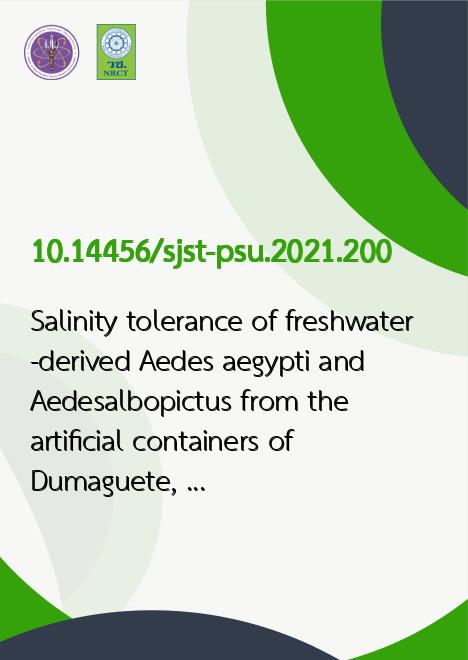
|
Salinity tolerance of freshwater-derived Aedes aegypti and Aedesalbopictus from the artificial containers of Dumaguete, Philippines |
|---|---|
| รหัสดีโอไอ | |
| Creator | 1. Venus Bantoto-Kinamot 2. Jaydon Soringa Lomoljo |
| Title | Salinity tolerance of freshwater-derived Aedes aegypti and Aedesalbopictus from the artificial containers of Dumaguete, Philippines |
| Publisher | Research and Development Office, Prince of Songkla University |
| Publication Year | 2564 |
| Journal Title | Songklanakarin Journal of Science an Technology (SJST) |
| Journal Vol. | 43 |
| Journal No. | 5 |
| Page no. | 1535-1541 |
| Keyword | development, Aedes aegypti, Aedes albopictus, salinity tolerance, brackishwater |
| URL Website | https://rdo.psu.ac.th/sjst/index.php |
| ISSN | 0125-3395 |
| Abstract | This study examined the response and tolerance of freshwater-derived Aedes aegypti and Aedes albopictus on salinity.Pre-imaginal stages of both species were exposed to salt concentration ranging from 3.5, 7, 10.5 ppt under laboratory conditions.The maximum salinity tolerance of Ae. aegypti and Ae. albopictus was at 7 ppt. Survival rate ranged from 53% to 93% and 63%to 90% for Ae. aegypti and Ae. albopictus, respectively. Percent emergence of Ae. aegypti ranged from 50% to 90%; 60% to 90%for Ae. albopictus. As salinity increases, larval duration increases while growth rate decreases. The LC50 for Ae. aegypti rangedfrom 6.1-7.1 ppt while LC90 ranged from 9.8-11.6 ppt. The LC50 of Ae. albopictus ranged from 6.5-7.1 ppt while LC90 rangedfrom 10.4-11.6 ppt. Findings of this study confirmed the need to implement control programs for mosquito vectors that alsotarget brackishwater. |
